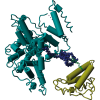This month: pyhlogenetic trees

What is a phylogenetic tree?
A diagram that represents evolutionary relationships among organisms based upon similarities and differences in their physical or genetic characteristics.
Why are we looking at them?
Scientists and clinicians in the University of Cambridge have used phylogenetic trees for a genomics study identifying routes of transmission of coronavirus in care homes.
What did they find?
For several care homes with the highest number of cases, all of the cases clustered closely together on a phylogenetic tree with either identical genomes or just one base pair difference. This was consistent with a single outbreak spreading within the care home. By contrast, for several other care homes, cases were distributed across the phylogenetic tree, with more widespread genetic differences, suggesting that each of these cases was independent and not related to a shared source.
Can you go into any specifics?
The team found two clusters linked to healthcare workers. One involved care home residents, a carer from that home and another from an unknown care home, paramedics and people living with them. The second involved several care home residents and acute medical staff at Cambridge University Hospitals NHS Foundation Trust who cared for at least one of the residents.
Why is this information important?
Using this technique of genomic surveillance can help institutions, such as care homes and hospitals, better understand the transmission networks that allow the spread of COVID-19. This can then inform infection control measures, helping ensure that these places are as safe as possible for residents, patients, staff and visitors.
Is there anywhere I can read more about this?
As always, there is indeed. To read their paper, visit – bit.ly/386fkox
Image credit | iStock




